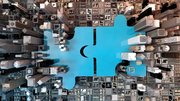News
Early adopters share tech triumphs, travails
Audio-enabled ATMs, wireless telecommunications and Web applications were covered in several tech-oriented presentations at the recent ATM & Debit Forum in Baltimore.
October 29, 2002
Several of the presentations at "Payment System Optimization," last week's ATM & Debit Forum sponsored by Thomson Media, focused on common-sense strategies for managing ATM networks. (See related story Keeping it real with retail ATMs)
Others, however, focused less on tactics and more on technology.
Wayne Malone, Citibank's vice president of Distribution Management, described his bank's efforts to voice-enable its network of 2,600 ATMs. The bank is on target to meet its goal of having at least one voice-enabled ATM at all 370 of its branches by the end of this month, he said.
Ahead of the ADA curve
Citibank installed its first ATMs in 1977 and began introducing Braille in the late 1980s, before the Americans With Disabilities Act (ADA) took effect in 1992, Malone said. In 1993, the bank introduced what it called a tap screen for visually impaired users.
The tap screen interface was proprietary, Malone said, because Citibank designed and built its own ATMs -- all of which used touchscreens -- until recently.
Malone showed a graphic of an early tap screen, which was divided into four quadrants and allowed users to perform two transactions: get cash or make a deposit. Braille on the fascia surrounding the screen guided users on how to activate the transactions; an audible tone let them know if the process had been successfully initiated.
For more on ADA |
The user tapped "go" to proceed with the transaction and "exit" to cancel. Transactions were automatically terminated if a user didn't touch the screen for two minutes.
Navigating through PINs presented the biggest challenge to users, Malone said. To do so, they tapped multiple times -- three taps to correspond with the numeral "3" for example -- followed by "go" until a PIN had been successfully entered. Dollar amounts were entered in the same way.
Tapping and text-to-speech
In 2001, Citibank introduced its first 10 ATMs with audio capabilities, in New York and California. Those machines still featured a tap screen interface, albeit a more sophisticated one in which ATM users can perform a variety of transactions.
After a user inserts a headset into an audio jack near the card reader, he will hear instructions on how to use the machine, which he can skip by tapping one of three quadrants on the bottom of the screen. The quadrants allows him to "select" transactions, go back to "previous" options or advance to the "next" option. PINs and dollar amounts are entered in the same fashion as on the earlier tap screen.
The machines use a text-to-speech software program rather than the WAV files used by several other financial institutions that have already introduced audio ATMs. While WAV files are more expensive and less flexible, they sound more "human" than text-to-speech programs.
Indeed, after Malone played examples of Citibank's audio, several members of the audience seemed unhappy with the robotic-sounding voice. However, Malone said, there are ongoing improvements in the sound quality of text-to-speech programs. Also, most visually impaired persons are accustomed to the mechanical tone, as they use similar programs on their home PCs.
Malone pointed out the thorough nature of the audio, which included descriptions of such details as which way money and receipts would be dispensed - with long and short ends, respectively, facing the user. "That's the kind of stuff that sighted individuals take for granted, but not all visually impaired customers know it," he said.
On the drawing board, Malone said, are plans to add a Spanish language option to audio instructions and possibly Braille receipts.
He also said that Citibank would eventually like to provide audio on the 1,400 or so ATMs it has in other countries.
Removing the wires
Jim Walker, a senior vice president at PNC Bank, seemed thrilled with his bank's experiences with Cellular Digit Packet Data (CDPD), which it has installed on about 200 ATMs in the past year.
"We're pleased so far, and we gain confidence in it every day," said Walker, adding that CDPD has become the primary telecommunications method for PNC's new installations and will replace leased line or dial-up on many of its already-installed 2,579 off-site machines in 2003.
Concord EFS drives all of PNC's 3,473 ATMs. PNC uses a frame relay system for its branch ATMs and ISDN, frame relay, satellite or dial-up for its off-site machines. Many of PNC's off-site locations are high volume, averaging more than 4,500 transactions a month.
With those volumes, dial-up can be expensive as there is a small connection charge for each transaction, Walker said. Another issue with dial-up is monitoring. Because it lacks an "always on" connection and only connects to the host for transactions, it's more difficult to monitor dial-up ATMs, Walker added.
With leased line, the primary problems are the 60- to 90-day lead times required for installation and the difficulty of laying wire at sites like shopping malls. "We've had ATMs out in a walkway at malls where we've had to dig trenches to get the wires to go where we needed them to," Walker said.
In praise of CDPD
Touting the benefits of CDPD, Walker said installation is generally a snap because it requires only a modem (PNC uses a Sierra Wireless Air Pac 300) and a small antenna placed on top or near the ATM (PNC conceals the antenna in a topper).
CDPD simulates a leased line with an "always on" connection, Walker said. The ATM communicates with a cell tower, which transmits the data to PNC's frame relay system in Pittsburgh, and then on to Concord via a T1 link.
For more on CDPD |
One of the biggest advantages to CDPD, Walker said, is the ease of moving a machine. It's been a big plus for PNC with its mall locations. "Sometimes when they're remodeling a mall, we have to move an ATM three or four times. That can create a real problem with down time."
CDPD's monthly cost is competitive with dial-up or about half the cost of a leased line, Walker said. The reliability of CDPD also compares favorably with leased line, he said.
No complicated diagnostics are required for repairs, Walker said. Instead, vendors simply swap out the modem if necessary.
"In terms of maintenance, installation and movement, (CDPD) has it all over everything else," Walker said.
CDPD's biggest disadvantage is its still-limited coverage area. Walker said only about 50 percent to 70 percent of PNC's ATM network -- with most locations in Pennsylvania, New Jersey, Delaware, Ohio, Kentucky and Indiana -- qualifies for CDPD. Some major metro areas, including Atlanta, lack coverage.
"My guess is it's based on supply and demand. I don't know how much demand there is for data lines," Walker said. "What I'd really like is for all of (the audience) to go and bang on doors and order these lines."
Getting to know you at the ATM
Jim D'Aprile, Fleet Bank's vice president of Self Service/ATM Banking, discussed Fleet's efforts to improve customer experience at the ATM, primarily through offering them more opportunities for personalization.
Fleet also wanted to leverage its 3,653 ATMs, which generate 256 million transactions each year, 79 percent of them performed by Fleet customers.
D'Aprile described a familiar Catch 22 for banks. "The more successful you are at moving the customer out of the branch and into other channels, the less opportunity you have to get to know them," he said.
Part of Fleet's initiative included a redesign of its ATM receipt to offer more complete information on multiple accounts. Fleet also began allowing customers to get cash advances from home equity accounts at the ATM -- an option exercised by 800 customers in the first month it was offered. And it offered them three different choices of mini-statements: last five checks, last five debit transactions or last 10 transactions (customers pay 50 cents for the information).
For more on Web apps |
Fleet made it possible for customers to create language, receipt and Fast Cash (standard withdrawal amount and account) preferences. Fast Cash was popular, with 5,000 customers setting preferences in the first month the service was offered, D'Aprile said.
Fleet uses a newly-purchased automated software distribution system to download screens marketing these new services, D'Aprile said. The system makes it possible to create targeted promotions, a boon to Fleet which D'Aprile said uses different public service campaigns in different states, for example.
D'Aprile said the system, while expensive, paid for itself quickly by eliminating sneakernet, or visits to each ATM to manually load content for ad campaigns. "After the first couple of distributions, we had our money back."
The automated software system also allowed Fleet to conduct a pilot in which some 320,000 customers were pre-approved for a credit card at a special rate and could accept the offer right at the ATM. According to D'Aprile, the pilot -- which was presented at 200 ATMs -- delivered a 30 percent lift over direct mail campaigns. (See related story On target with ATM advertising)
Wide world of Web
Fleet intends to take its personalization and cross-marketing efforts even further when it adds more ATMs based on a Microsoft Windows operating system to its network. Fleet has already rolled out 32 of these machines and hopes to have 150 more in 2003's first quarter, D'Aprile said.
Perhaps the biggest benefit to using Web technologies, D'Aprile said, is the "immediate cut in development costs," as applications created for the bank's Web site can be easily moved to the ATM. Fleet will test this when it begins offering bill payment at its ATMs next year.
"It's good to think outside the box, but you have to remember the box is an ATM." |
Fleet is using NCR'sAPTRA Edge software. All of the machines currently running the software are NCRs, but D'Aprile said the bank plans to introduce it on DieboldATMs in the first quarter. The composition of Fleet's fleet is about 60 percent NCR machines, with the remainder Diebold ATMs.
"Quite frankly, we wanted to play it safe," he said of Fleet's decision to roll out APTRA Edge on just NCR ATMs first. "We wanted to be able to fix any bugs with our dominant vendor."
A few caveats
While D'Aprile enthused about "the new world of Web-enabled technology," he admitted there were a few early glitches. It's important, he said, to ensure that those designing ATM interfaces understand that "the ATM is a different beast" than a Web site. Fleet's first few efforts never made it to the ATM. "They looked fine to the guys sitting there designing them on their PCs, but they just didn't play on the ATM," he said.
After the first 127 transactions on a Windows-based ATM which was being used only by Fleet employees, a screen popped up with a request to reset the password, not a command normally seen in the OS/2 world. To solve such issues, D'Aprile said, "Your vendor needs to be intimately involved with your development staff."
He added, "There are some things you just can't test until you get them on an ATM platform. Lock an engineer and a designer in a room with an ATM, and don't let them leave until they figure it out."
Another danger, D'Aprile said, is to let all of the Web-based possibilities overtake what he called the "trinity" of ATM transactions: speed, availability and intuitive nature.
"It's good to think outside the box, but you have to remember the box is an ATM," he said.
Included In This Story
Diebold Nixdorf
As a global technology leader and innovative services provider, Diebold Nixdorf delivers the solutions that enable financial institutions to improve efficiencies, protect assets and better serve consumers.














